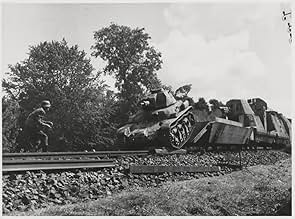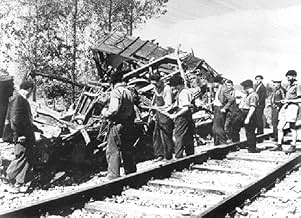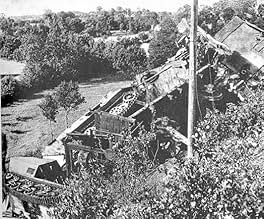IMDb-BEWERTUNG
7,0/10
1387
IHRE BEWERTUNG
Dieser Film ist eine Geschichte über die französischen Eisenbahnarbeiter, die während der deutschen Besatzung im Zweiten Weltkrieg Teil des organisierten Widerstands waren.Dieser Film ist eine Geschichte über die französischen Eisenbahnarbeiter, die während der deutschen Besatzung im Zweiten Weltkrieg Teil des organisierten Widerstands waren.Dieser Film ist eine Geschichte über die französischen Eisenbahnarbeiter, die während der deutschen Besatzung im Zweiten Weltkrieg Teil des organisierten Widerstands waren.
- Regie
- Drehbuch
- Hauptbesetzung
- Auszeichnungen
- 3 Gewinne & 1 Nominierung insgesamt
Marcel Barnault
- Cheminot
- (as Barnault)
Jean Clarieux
- Lampin
- (as Clarieux)
Jean Daurand
- Cheminot
- (as Daurand)
Lucien Desagneaux
- Athos
- (as Desagneaux)
François Joux
- Cheminot
- (as Joux)
Pierre Latour
- Cheminot
- (as Latour)
Robert Le Ray
- Chef de gare
- (as Leray)
Pierre Lozach
- Cheminot
- (as Lozach)
Pierre Mindaist
- Cheminot
- (as Mindaist)
Léon Pauléon
- Chef de gare St-André
- (as Pauleon)
Fernand Rauzéna
- Cheminot
- (as Rauzena)
Michel Salina
- Allemand
- (as Salina)
Charles Boyer
- Narrator
- (Synchronisation)
- (Nicht genannt)
Empfohlene Bewertungen
Trains have been a perennial feature of film iconography since Melies filmed a train entering La Ciotat station in 1895, while the cattle trucks of 'Nuit et Broullard' has long been a defining image of the Holocaust.
The depiction of the mechanics of railways will delight most trainspotters although they will probably be more distressed by those that (SLIGHT SPOILER COMING:) get wrecked rather than the people who get killed.
We know what type of people we are dealing with from the opening image of a poster targeting Juden proceeding through the familiar sight of Germans marching hapless passengers on to the platform while a German begins a speech "Kameraden" in tones that are far from comradely.
The depiction of the mechanics of railways will delight most trainspotters although they will probably be more distressed by those that (SLIGHT SPOILER COMING:) get wrecked rather than the people who get killed.
We know what type of people we are dealing with from the opening image of a poster targeting Juden proceeding through the familiar sight of Germans marching hapless passengers on to the platform while a German begins a speech "Kameraden" in tones that are far from comradely.
René Clément directed this exceptional film which captures an important but often ignored part of the Allied war effort in WWII. It chronicles the efforts by the French railway workers to hinder the German war machine. What makes the film work wonderfully is the non-professional actors--like the Neo-realist actors in post-war Italian films (such as by DeSica and Rossellini). This gives the movie a great sense of realism--almost like a documentary that was somehow filmed as events really took place--though it was made just after the war.
The film begins sometime after the German occupation began--it's never exactly certain. During this time, random acts of sabotage occur but they are mostly annoying and are seemingly unorganized. However, partway through the film, the Resistance receives word that the Normandy invasion has occurred. Suddenly, the full extent of the French Resistance is obvious, as the entire effort to use the rails to reinforce the German army are frustrated in many, many ways--ranging from sabotaging the tracks and equipment to even attacks on the trains themselves by partisans.
"La Bataille du Rail" ("The Battle of the Rails") works very well--mostly because in addition to the non-actors working in the film, the director and writers (one of which was the director himself) used a lot of tense little vignettes in the film to draw in the viewer. Perhaps some today might find it all a bit boring (after all, they are more interested, perhaps, in seeing the newest Brandon Frazier film), but as a history teacher, I think it's a must-see! Wonderful.
By the way, you can't blame the film makers for this, but the print I saw was pretty shabby. It had a lot of scratches and the white captions were poor--blending into the scenes at times and also, occasionally, mistranslated or using jargon that is too technical (full of railroad terms and jargon). I would LOVE to see this film restored and re-captioned!
The film begins sometime after the German occupation began--it's never exactly certain. During this time, random acts of sabotage occur but they are mostly annoying and are seemingly unorganized. However, partway through the film, the Resistance receives word that the Normandy invasion has occurred. Suddenly, the full extent of the French Resistance is obvious, as the entire effort to use the rails to reinforce the German army are frustrated in many, many ways--ranging from sabotaging the tracks and equipment to even attacks on the trains themselves by partisans.
"La Bataille du Rail" ("The Battle of the Rails") works very well--mostly because in addition to the non-actors working in the film, the director and writers (one of which was the director himself) used a lot of tense little vignettes in the film to draw in the viewer. Perhaps some today might find it all a bit boring (after all, they are more interested, perhaps, in seeing the newest Brandon Frazier film), but as a history teacher, I think it's a must-see! Wonderful.
By the way, you can't blame the film makers for this, but the print I saw was pretty shabby. It had a lot of scratches and the white captions were poor--blending into the scenes at times and also, occasionally, mistranslated or using jargon that is too technical (full of railroad terms and jargon). I would LOVE to see this film restored and re-captioned!
A hidden gem l just discovered !! Tells it like it was !! Dirty , hard , people died . Very good de-railment scene towards the end !! A real derailment excellently shot !
For cinema enthusiasts, it is important to learn that the value of trains in the field of cinema has always been justly understood by filmmakers as truthful portrayals of trains have been extremely useful in making films which have become extremely popular with critics as well as with viewers. It would be appropriate to state that most of the films about war have an air of authenticity due to the realistic depiction of trains in them. It would not be an exaggeration to state that war films are popular due to the portrayal of trains in them. La Bataille Du Rail/The Battle of the Rails is the best example of a war film with trains and their impact on war as its major plot. The success of this film is due to the efforts of ordinary railway workers in war time France who were quick to realize that the damage to railway system in occupied France would be a key weapon in their fight against Nazi Germany. Those who favor technology in cinema would be shocked to learn how professionally the massive annihilation of trains was carried out in "The Battle of the Rails" despite the evident lack of technology. In 1946, this film by René Clément won a jury prize at Cannes Film Festival. In recent times, La Bataille Du Rail/The Battle of the Rails has been hailed as one of the classics of world cinema as it was shown in "Cannes Classics" section during 63rd Cannes International Film Festival held in 2010. Hardcore cinema enthusiasts would be thrilled to learn that it has been fully restored by INA in France where it can also be watched on DVD as well as Blu Ray formats.
Rene Clement's first feature about the French rail workers who under the strangle hold of the dirty Nazis put up a fight by causing chaos with the running of the trains. A neo-realist style with unprofessional actors.
Wusstest du schon
- WissenswertesIn part financed by what had been the Resistance as a way of showing international audiences what the French population had been facing under Nazi oppression. The Resistance was also keen to let the world know that they had been actively involved in disrupting the German war machine in France as the international perception at the time was that the French had capitulated and collaborated a little too easily with their Nazi captors.
- PatzerRailway worker tapping Morse code just repeats letter "V" most of the time with only a few exceptions.
- Crazy Credits(in cast) et Les cheminots de France
- VerbindungenFeatured in Cannes... les 400 coups (1997)
Top-Auswahl
Melde dich zum Bewerten an und greife auf die Watchlist für personalisierte Empfehlungen zu.
- How long is The Battle of the Rails?Powered by Alexa
Details
- Erscheinungsdatum
- Herkunftsland
- Offizieller Standort
- Sprachen
- Auch bekannt als
- Die Schienenschlacht
- Drehorte
- Gare SNCF, Saint-Brieuc, Côtes-d'Armor, Frankreich(first scenes, train station)
- Produktionsfirmen
- Weitere beteiligte Unternehmen bei IMDbPro anzeigen
- Laufzeit1 Stunde 25 Minuten
- Farbe
- Sound-Mix
- Seitenverhältnis
- 1.37 : 1
Zu dieser Seite beitragen
Bearbeitung vorschlagen oder fehlenden Inhalt hinzufügen

Oberste Lücke
By what name was Schienenschlacht (1946) officially released in Canada in English?
Antwort



















